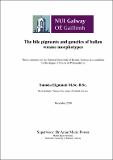| dc.description.abstract | All fish have the pigment bilirubin in their blood which results from the breakdown of haemoglobin, however, some Labridae and other species also have an alternative pigment known as biliverdin which results in blue-green coloured plasma. The functional role of alternative forms of blood pigment is still unclear. Labrus bergylta is a protogynous hermaphrodite, distinguished for its various morphotypes based on diverse colours and patterns. The current study has distinguished four different morphotypes sampled from two locations in Galway Ireland (n=57 from Carna 2015, n=21 from Carna 2016, n=37 from Spiddal 2015 and n=34 Spiddal 2016), which were classified as: ‘plain’, ‘spotted’, ‘merle’ and ‘intermediate’. A series of hypotheses were tested, the first one being an association between the presence of biliverdin in blood plasma and the hermaphroditic reproductive mode. To determine presence of bili-pigments, blood plasma from several coastal fish species with either hermaphrodite or gonochoristic life histories were examined using colorimetry readings (L* a* b* scores) and scanning UV spectrophotometry to examine absorbance spectra. L* a* b* scores and peaks in absorbance spectra for gonochoristic fish species showed a range of plasma colourations: pinkish, blue-green and yellow/green, hence they did not support the hypothesis of a link between the hermaphroditic reproductive mode and plasma colouration. For L. bergylta only, the plasma pigments were extracted and confirmed to be biliverdin and bilirubin using Mass Spectrometry. The next set of experiments examined links between biliverdin/bilirubin concentration in blood plasma (determined using a pigment extraction procedure known as the spectrometric method) and the four observed morphotypes in L. bergylta, along with possible connections to body size and a series of basic haematology variables (including packed cell volume (haematocrit), haemoglobin, blood cells count and blood indices). Overall, there were differences between the morphotypes in three variables: body size, biliverdin and total bilirubin concentrations (plasma), which when combined, were predictive of morphotype(s). Merle was the shortest and the lightest morph, while the spotted and intermediate morphotypes were the largest and the heaviest. In plain morphotypes, total bilirubin in the plasma was higher, while the other morphs overlapped in this variable. Plasma biliverdin concentration, on the other hand, was the highest for both plain and intermediate individuals and the lowest in merle. Despite these gross patterns, comparing pigment concentrations in the plasma between locations and years showed high variability: the bilirubin concentration in both locations and years was higher than biliverdin except for Carna 2015. The next aim was to speculate as to the role of pigments in camouflage, to establish connections (or not) between morphotype and accumulation of biliverdin in external tissues (skin and scales) on the dorsal and ventral body surfaces. To do this, colorimetric readings (L* a* b* scores) were taken, both from external tissue surfaces and in extracts made from these tissues. In addition, biliverdin was extracted from external tissues and its concentration measured using the spectrometric method. Correlations (if any) between biliverdin concentrations in external tissue extracts and concentrations in plasma for the same individuals were then examined. Overall (both locations combined), biliverdin concentrations in external tissues (skin and scales) and plasma of L. bergylta were positively correlated. In both locations, biliverdin concentrations extracted from skin was also positively correlated with biliverdin extracted from scales. Finally, comparison of biliverdin concentrations in external tissues between the morphotypes in Carna revealed variations in the skin and scales (in 2015 only), where the smaller morph (merle) had lowest concentrations, but larger morphs (spotted and intermediate) had highest biliverdin concentrations. The latter was a similar pattern to what was observed overall in plasma concentrations, however, this pattern did not apply to other years/locations. In the final research chapter, the four different morphotypes were analysed using two genetic markers, i.e. the mitochondrial cytochrome oxidase subunit I (COI) gene and mitochondrial DNA control region (CR) sequences to investigate i) whether all morphotypes present can be identified genetically as L. bergylta species and also ii) to examine genetic variability of morphotypes. Genetic population structure was sampled at both Carna and Spiddal (2015 and 2016) and CR sequences were also compared with unknown morphs of L. bergylta from ten locations after accessing sequence data from Genbank. The latter were divided into 3 regions based on latitude (‘Britain and Ireland’, ‘Azores’ and ‘Norway’). No genetic differences between the morphotypes was observed in haplotype networks (COI/CR genes) and AMOVA (CR). Ignoring morphotype and placing samples from this study within the broader geographic regional context (i.e. Ireland/UK, Norway and Azores) using the CR gene showed that Irish populations were separated from the Azores but were not completely separated from Norway populations. Since biliverdin/bilirubin concentration in plasma is related to morphotypes and body size and since plasma biliverdin is somewhat linked to its concentration in external tissues, it is proposed that one of the roles of biliverdin may be in signalling of some sort to conspecifics. Alternatively, because concentrations were also quite variable across locations/years (varying from site to site), biliverdin may function in camouflage, or because it is a strong antioxidant, may perform as a photoprotector or some other adaptation to life in shallow water. Further research is needed to understand the physiological role of biliverdin in certain morphs, years and locations. As the results do not indicate genetic isolation between the morphotypes, additional investigations are required to determine the reasons behind the morphotype variations in the life history of L. bergylta. | en_IE |


